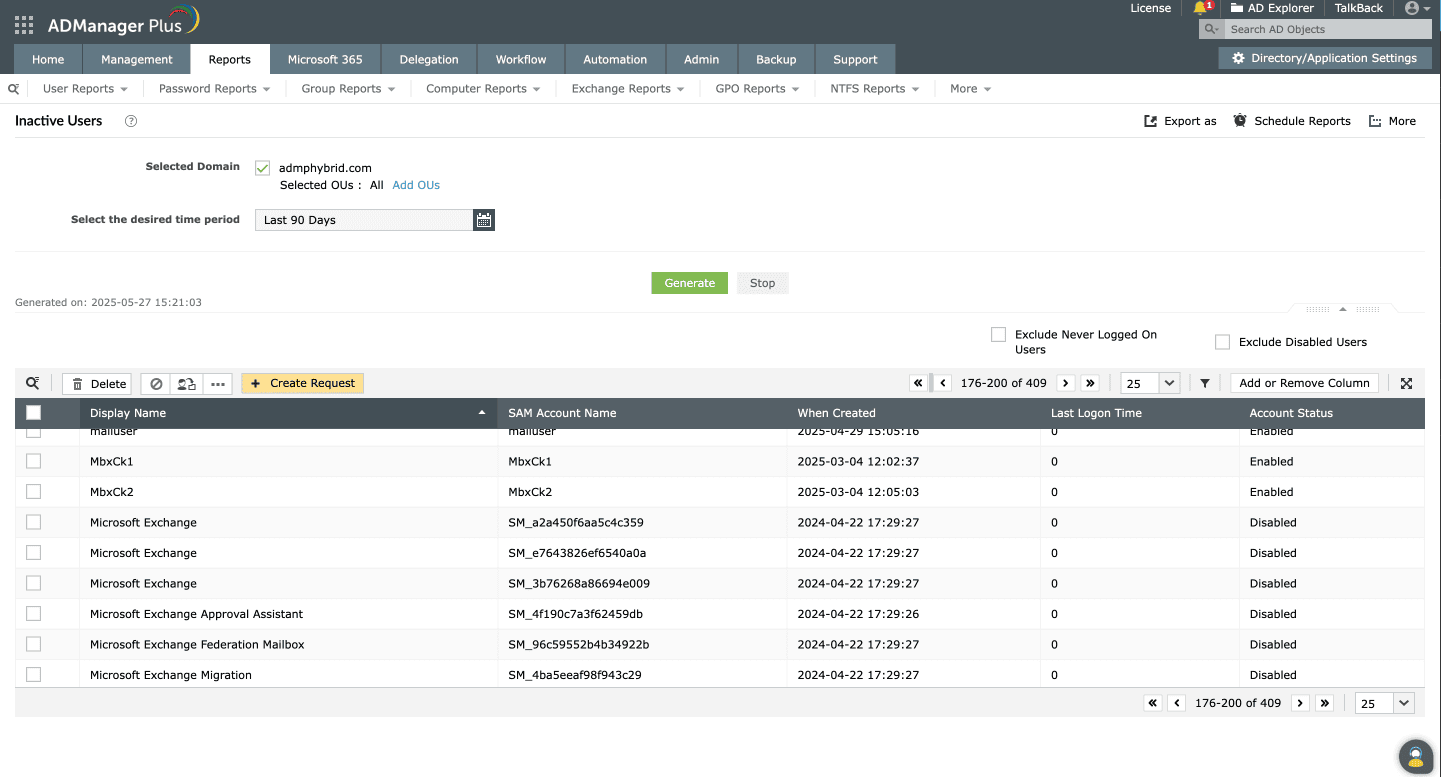Knowing how to identify active user accounts is crucial for security audits, license management, and ensuring smooth operations. While most admins use PowerShell to accomplish this, it can be time-consuming and complex. On the other hand, ADManager Plus, an Active Directory (AD) reporting tool, empowers admins to get a report of all active AD users in just a few clicks.
The following table lists the steps to get all active AD users using PowerShell and ADManager Plus:
Prerequisite
Ensure the AD module is installed. If not, download the correct RSAT package for your OS and run the command below to activate the module.
Import-Module ActiveDirectory
Using Get-ADUser to filter active users
Run the following script to fetch active AD users. This uses the Get-ADUser cmdlet with a filter to find only accounts where the Enabled property is set to $True.
Get-ADUser -Filter {Enabled -eq $True} -Properties DisplayName, EmailAddress

Get-ADUser -Filter 'Enabled -eq $True'
Get-ADUser -Filter {Enabled -eq $true} -Properties DisplayName, LastLogonDate |
Select-Object Name, DisplayName, LastLogonDate |
Sort-Object LastLogonDate -Descending
Get-ADUser -Filter {Enabled -eq $True} -SearchBase "OU=Sales,DC=domain,DC=com" -Properties DisplayName, EmailAddress |
Select-Object Name, DisplayName, EmailAddress
Get-ADUser -Filter {Enabled -eq $True} -Properties SamAccountName, EmailAddress |
Select-Object SamAccountName, EmailAddress |
Export-Csv -Path "EnabledUsers.csv" -NoTypeInformation
The following are essential parameters that can be used for listing active AD users:
| Column | Description |
|---|---|
| -Filter | Specifies a filter string in PowerShell expression format to limit which user objects are returned. |
| -Properties | Specifies additional AD properties to retrieve beyond the default set, such as DisplayName and EmailAddress. |
| -Identity | Checks a specific user by username or SamAccountName. |
| -Export-Csv | Used to export the report to a CSV file (not a cmdlet parameter, but used in the pipeline). |
| -Path | Output file path for exported report. |
Even with the right commands, fetching active user data using PowerShell can occasionally result in errors or incomplete outputs. Here are some common issues and how to resolve them:
Cause: The AD module isn't installed or imported.
Solution: Ensure you're running PowerShell on a system that has RSAT: AD tools installed. Import the module manually by running the command below:
Import-Module ActiveDirectory
Cause: Some properties like LastLogonDate aren't included by default.
Solution: Always specify required properties explicitly using the -Properties parameter as given below:
Get-ADUser -Filter {Enabled -eq $true} -Properties LastLogonDate
Cause: Your PowerShell session doesn't have adequate permissions.
Solution: Run PowerShell as an administrator.
Cause: Misconfigured filter or incorrect OU specified.
Solution:
While powerful, relying solely on PowerShell for extensive user reporting can present challenges:
ADManager Plus bridges the gap between powerful AD reporting and ease of use. Here's why it's a better choice for many IT teams:
To find users who have logged in within the last 90 days, you can use the Get-ADUser cmdlet in PowerShell and filter based on the lastLogonTimestamp attribute:
$NinetyDaysAgo = (Get-Date).AddDays(-90)
Get-ADUser -Filter {lastLogonTimestamp -ge $NinetyDaysAgo.ToFileTime()} -Properties Name, lastLogonTimestamp |
Select-Object Name, @{Name="LastLogon"; Expression={[datetime]::FromFileTime($_.lastLogonTimestamp)}}
Alternatively, you can use ADManager Plus to quickly generate AD logon reports that show users who have logged in within your specified time frame.
To find active users who haven't logged in for a specific period (e.g., 60 days), use this PowerShell script:
$daysInactive = 60
$inactiveDate = (Get-Date).AddDays(-$daysInactive)
Get-ADUser -Filter {Enabled -eq $True -and LastLogonDate -lt $inactiveDate} -Properties LastLogonDate | Select-Object Name, SamAccountName, LastLogonDate
For a script-free approach, use ADManager Plus' Logon Reports to quickly identify inactive users or those who haven't logged in recently.
You can retrieve a list of AD users in PowerShell using the Get-ADUser cmdlet. For detailed steps with examples and supported parameters, click here.
In AD, an Enabled user is one whose account is not disabled and is technically allowed to log in (Enabled = True). However, this doesn't mean the user is actively using the account. An Active user typically refers to an enabled account that has logged in recently, usually within a defined time frame like the last 30, 60, or 90 days. So while all active users are enabled, not all enabled users are necessarily active.
Yes, ADManager Plus offers automation and scheduling features for user reports, including those on active, inactive, and recently logged-on users. Reports can be automatically delivered to the specified email addresses. You can also configure notification templates to receive alerts whenever a management task is completed.